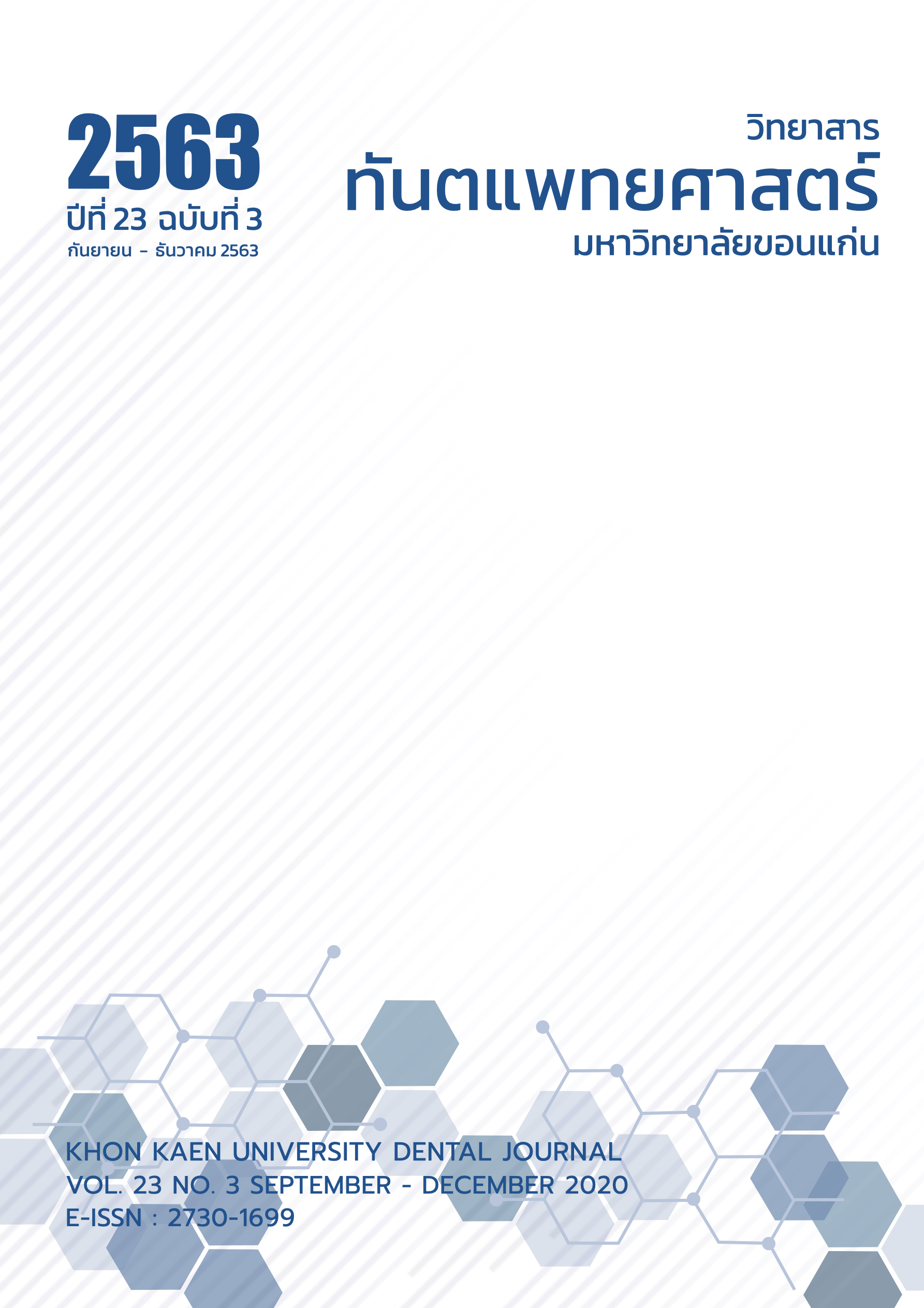A Study on Fracture Resistance of Tie-Wings and Shear Bond Strength of Srinakharinwirot Aluminum Oxide Ceramic Orthodontic Brackets
Main Article Content
Abstract
The objectives of the study were to find average surface curvature of premolars of Thai samples, to develop Srinakharinwirot (SWU) ceramic bracket by incorporating this curvature into its base and to compare its fracture resistance of tie-wings and shear bond strength with commercial brackets. Buccal surfaces of 40 upper premolars from Thai samples were scanned and averaged into one surface curvature. SWU ceramic bracket was designed by incorporating the derived curvature into its base and fabricated by injection-mold technique. Fracture resistance of tie-wings and shear bond strength was compared between SWU ceramic brackets and commercial brackets. It was found that average buccal surface curvature of upper premolars of Thai samples was less than the commercial bracket base. Analysis by independent t-test showed that fracture resistance of tie wings and shear bond strength were statistically significant lower (p<0.05) in SWU ceramic brackets (48.38 ± 9.95 MPa and 15.01 ± 5.45 MPa, respectively) compared to the controls (126.28 ± 33.96 MPa and 31.76 ± 6.49 MPa, respectively). In conclusion, SWU ceramic bracket was developed using the average buccal surface curvature of upper premolars of Thai samples. Although shear bond strength of SWU ceramic bracket were lower than the commercial brackets, it was found to be clinically acceptable.
Article Details
บทความ ข้อมูล เนื้อหา รูปภาพ ฯลฯ ที่ได้รับการลงตีพิมพ์ในวิทยาสารทันตแพทยศาสตร์ มหาวิทยาลัยขอนแก่นถือเป็นลิขสิทธิ์เฉพาะของคณะทันตแพทยศาสตร์ มหาวิทยาลัยขอนแก่น หากบุคคลหรือหน่วยงานใดต้องการนำทั้งหมดหรือส่วนหนึ่งส่วนใดไปเผยแพร่ต่อหรือเพื่อกระทำการใด ๆ จะต้องได้รับอนุญาตเป็นลายลักษณ์อักษร จากคณะทันตแพทยศาสตร์ มหาวิทยาลัยขอนแก่นก่อนเท่านั้น
References
Russell JS. Current Products and Practice Aesthetic Orthodontic Brackets. J Orthod 2005;32(2):146-63.
Eliades T. Orthodontic materials research and applications: Part 2. Current status and projected future developments in materials and biocompatibility. Am J Orthod Dentofacial Orthop 2007;131(2):253-62.
Karamouzos A, Athanasiou AE, Papadopoulos MA. Clinical characteristics and properties brackets: A comprehensive review. Am J Orthod Dentofac Orthop 1997;112(1):34-40.
Didron PP, Sombutham N, Pittayachawan P. A study on fracture resistance of tie-wings and frictional resistance at the bracket slot floor of aluminum oxide ceramic orthodontic bracket [dissertation]. Bangkok (TH): Srinakharinwirot Univ.;2017
International Organization for Standardization. [homepage on the Internet]. Geneva: ISO/TS 11405: 2015.-Dentistry-Testing of adhesion to tooth structure. Available from: https://www.iso.org/standard/62898.html
Chuankrerkkul N, Wasanapiarnpong T, Noomun K, Powder injection moulding of dental ceramic brackets using water soluble binder. Chiang Mai J Sci 2018; 45(5):2190-4.
Johnson G, Walker MP, Kula K. Fracture strength of ceramic bracket tie wings subjected to tension. Angle Orthod 2005;75(1):95-100.
Eslamian L, Borzabadi FA, Mousavi N, Ghasemi A. A comparative study of shear bond strength between metal and ceramic brackets and artificially aged composite restorations using different surface treatments. Eur J Orthod 2012;34:610-7.
Zielinski V, Reimann S, Jäger A, Bourauel C. Comparison of shear bond strength of plastic and ceramic brackets. J Orofac Orthop 2014;5:345-57.
Årtun, J, Bergland S. Clinical trials with crystal growth conditioning as an alternative to acid-etch enamel pretreatment. Am J Orthod 1984;85:333–40.
Thonggerd W, Wasanapiarnpong T, Didron PP, Sombuntham N. A study on buccal surface curvature of maxillary premolars of Thai samples by three dimensional scanning. SWU Dent J 2020. In press.
Reynolds IR. A Review of Direct Orthodontic Bonding. Br J Orthod 1975;2(3):171-8.
Hanihara T, Ishida H. Metric dental variation of major human populations. Am J Phys Anthropol 2005;128(2): 287-98.
Manabe Y, Ito R, Kitagawa Y, Oyamada J, Rokutanda A, Nagamato S, et al. Non-metric tooth crown traits of the Thai, Aka and Yao tribes of Northern Thailand. Arch Oral Biol 1997;42(4):283-91.
Ramakrishnan K, Sharma S, Sreeja C, Pratima DB, Aesha I, Vijayabanu B. Sex determination in forensic odontology: A review. J Pharm Bioallied Sci. 2015;7(2): 398–402.
Jung MH. Survival analysis of brackets and tubes: A twelve-month assessment. Angle Orthod 2014;84(6): 1034-40.
Grauer D, Wiechmann D, Heymann GC, Swift EJ, Jr. Computer-aided design/computer-aided manufacturing technology in customized orthodontic appliances. J Esthet Restor Dent 2012;24(1):3-9.
Joiner M. In-house precision bracket placement with the indirect bonding technique. Am J Orthod Dentofacial Orthop 2010;137(6):850-4.
Gibbs SL. Clinical Performance of Ceramic Brackets: A survey of British orthodontists' experience. Br J Orthod 1992;19(3):191-7.
Lindauer SJ, Macon CR, Browning H, Rubenstein LK, Isaacson RJ. Ceramic bracket fracture resistance to second order arch wire activations. Am J Orthod Dentofacial Orthop 1994;106:481-6.
Ghosh J, Nanda RS, Duncanson MG, Currier GF. Ceramic bracket design: An analysis using the finite element method. Am J Orthod Dentofacial Orthop 1995; 108(6):575-82.
Wagnar N, Wyllie B, Thorstenson G. ClarityTM Advance Ceramic brackets: A Technical Perspective. European Innova 2013;3:68-70.
Proffit WR, Henry WF, David MS. Contemporary Orthodontics. 5th ed. St. Louis: Mosby Elsevier; 2007.
Nakhaei S, Agahi RH, Aminian A, Rezaeizadeh M. Discoloration and force degradation of orthodontic elastomeric ligatures. Dental Press J Orthod. 2017;22(2): 45-54.
Lawn BR, Deng Y, Lloyd IK, Janal MN, Rekow ED, Thompson VP. Materials design of ceramic-based layer structures for crowns. J Dent Res 2002; 81(6):433-8.
Scott GE, Jr. Fracture toughness and surface cracks--the key to understanding ceramic brackets. Angle Orthod 1988;58(1):5-8.
Lee YK. Translucency of Dental Ceramic, Post and Bracket. Materials (Basel) 2015;8(11):7241-9.
Yadav J, Mehrotra P, Kapoor S, Mehrotra R. Basis of orthodontics-bonding – A review. International Journal of Dental Science and Research 2013;1(1):28-33.
Zeppieri IL, Chung CH, Mante FK. Effect of saliva on shear bond strength of an orthodontic adhesive used with moisture-insensitive and self-etching primers. Am J Orthod Dentofacial Orthop 2003; 124(4):414-9.
Joseph VP, Rossouw E. The shear bond strengths of stainless steel and ceramic brackets used with chemically and light-activated composite resins. Am J Orthod Dentofacial Orthop 1990;97(2):121-5.
Redd TB, Shivapuja PK. Debonding ceramic brackets: effects on enamel. J Clin Orthod 1991;25(8):475-81.
Bishara SE, Fehr DE, Jakobsen JR. A comparative study of the debonding strengths of different ceramic brackets, enamel conditioners, and adhesives. Am J Orthod Dentofacial Orthop 1993;104(2):170-9.


